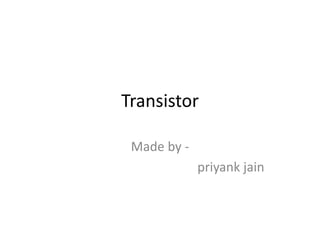
Transistor notes
- 1. Transistor Made by - priyank jain
- 3. introduction • A transistor is a semiconductor device used to amplify and switch electronic signals and electrical power. It is composed of semiconductor material with at least three terminals for connection to an external circuit. A voltage or current applied to one pair of the transistor's terminals changes the current flowing through another pair of terminals., a transistor can amplify a signal. found embedded in integrated circuits.
- 4. Transistor • Transistor are electrical device, which utilize a sandwich of p and n type of semi conductor materials. • It can be NPN or PNP types
- 5. Transistor • It has got 3 parts : • emitter • Base • Collector.
- 6. • One of the n type at the left is emitter • Right is collector • And central p type is the base
- 7. • When contact is being made between materials in case of NPN transistor PD develops at their junction and the emitter and collector being positive relative to the base.
- 8. Transistor • When the device is connected to a source of EMF, with the emitter negative and the collector positive, no current flows unless the EMF exceeds the critical value, as the electrons are unable to pass from the negative p-type to the positive n-type semiconductor, so cannot cross the base collector junction.
- 9. Transistor • A second source of EMF is connected to the base and the emitter, the base being positive relative to the emitter. • The electron can pass from the negative n type to the positive p-type • So the current flows across the base collector junction.
- 10. Transistor • In the circuit’ there is a thick layer of n-type semiconductor, a thin layer of p-type semiconductor’ so the current consist largely of the movement of electrons from the emitter soon pass into the base
- 11. Transistor • The base has now an adequate supply of electrons, and as it is very thin these come close to the base collector junction, and are attracted into the collector, to replace those that had migrated into the base.
- 12. Transistor • This reduces the barrier effect across the base-collector junction, and current flows across the transistor. • Thus a current fed into he base current, causes greater variation of current flowing across the transistor.
- 13. Transistor • In this respect the current fed into the base of the transistor has an effect, comparable to that of a positive charge applied to the grid of a triode valve.
- 14. Transistor • Uses of transistor • Transistor are used in preference to the valve in most modern equipment, as they are durable, have a long life, consume less power and need no heating device. • As the power output is limited they are suitable for use in the production of low frequency but fail to produce high frequency currents e.g. SWD
- 15. Thank you Priyank jain
